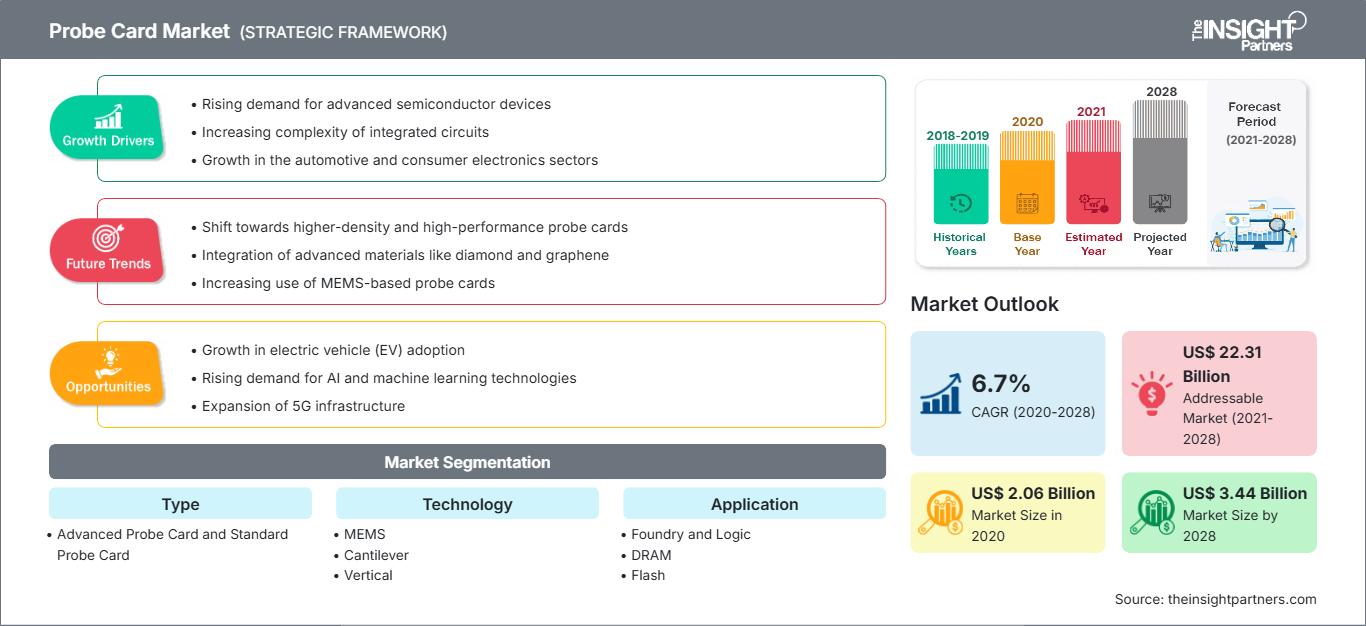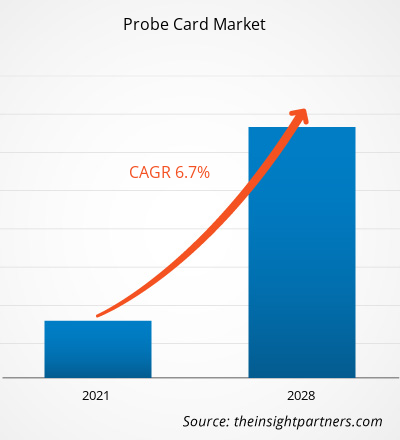探针卡市场规模预计将从 2020 年的 20.598 亿美元增至 2028 年的 34.368 亿美元;预计 2021 年至 2028 年期间市场将保持 6.7% 的复合年增长率,实现健康增长。
探针卡是一种用于测试半导体晶圆的接口。在半导体制造的初始步骤中,此过程用于评估集成电路或潜在语义索引的质量。在大多数情况下,探针卡以机械方式对接到探测器上,并以电气方式连接到测试仪上。探针卡的主要目的是在测试设备和晶圆上的电路之间建立电气连接,以便对电路进行测试。印刷电路板 (PCB) 和各种类型的接触元件是探针卡的基本组件。探针卡考虑了多种元素,其中一些非常常见,而另一些则具有非常特殊的用途。
随着手机、台式机、数码相机、平板电脑、笔记本电脑、硬盘和电视等的使用增加,以及新技术的不断研究和引进,消费电子行业得到了发展。智能设备和物联网的推出,以及平板电脑的普及和对大屏幕设备的需求激增,都促进了探针市场的增长。芯片尺寸趋势的变化以及对各种电子产品中创新架构的日益偏好推动了对半导体的需求。IC芯片制造规模的不断扩大导致对电子测试的需求激增,这又推高了对探针卡的需求。人工智能和物联网等现代技术与半导体生产设备的结合将加速其在制造工厂中的应用。此外,物联网设备对硅基传感器需求的增加、新兴国家芯片产业的扩张以及数据中心和服务器数量的增加,都是推动半导体行业业绩提升的因素,进而推动了探针卡的需求。
为最大程度地减少病毒传播而实施的全球封锁,严重扰乱了众多制造商(尤其是中小企业)的供应链活动和产量。由于工业部门和终端用户对电子元件的需求下降,半导体行业遭受了沉重打击。由于封锁期间未能进行大规模生产,微电子行业的盈利模式也出现了下滑。封锁结束后,随着生产设施采取保持社交距离的措施并重启运营,半导体行业开始重新夺回市场份额。此外,居家办公和远程监控策略也有助于提高先进电子产品的销量,从而改善连接性。IT和电信行业在通信方面的重要性日益凸显,这使得该行业能够利用物联网连接和高速Wi-Fi兼容封装技术等新技术不断发展。
自定义此报告以满足您的要求
您将免费获得任何报告的定制,包括本报告的部分内容,或国家级分析、Excel 数据包,以及为初创企业和大学提供超值优惠和折扣
探针卡市场: 战略洞察

- 获取本报告的主要市场趋势。这个免费样本将包括数据分析,从市场趋势到估计和预测。
您将免费获得任何报告的定制,包括本报告的部分内容,或国家级分析、Excel 数据包,以及为初创企业和大学提供超值优惠和折扣
探针卡市场: 战略洞察

- 获取本报告的主要市场趋势。这个免费样本将包括数据分析,从市场趋势到估计和预测。
根据探针卡市场报告,预计亚太地区将占据全球探针卡市场的大部分份额。亚太地区由中国、印度、日本、澳大利亚和韩国等最大和最具活力的经济体组成。台湾、中国大陆和日本是亚太地区领先的半导体制造国家。印度和中国等发展中国家的可支配收入不断增长,为智能可穿戴设备、智能手机和电动汽车等高科技消费电子产品带来了庞大的客户群。预计这一因素将推动该地区的探针卡市场发展。中国是 IC 封装技术产品的主要制造中心,而台湾、韩国和日本也是区域市场增长的重要贡献者。许多亚太国家都以大规模生产消费电子产品、汽车零部件、电信设备和其他工业机械所需的电子设备为特点。由于拥有充足的熟练人力资源,印度和中国的电子制造公司数量不断增加,推动了探针卡市场的增长。
探针卡市场细分
根据探针卡市场分析,市场分为类型、技术、应用和地域。根据类型,探针卡市场分为高级探针卡和标准探针卡。根据技术,探针卡市场分为 MEMS、悬臂和垂直。根据应用,探针卡市场分为代工和逻辑、DRAM、闪存等。地理分析基于北美、欧洲、亚太地区 (APAC) 和世界其他地区 (RoW) 等地区进行。
一些主要的探针卡市场参与者包括 FEINMETALL GmbH;FormFactor;富士通;GGB Industries;日本电子材料公司;韩国仪器有限公司;Micronics Japan Co., Ltd.;MPI Corporation;SV Probe;和 Technoprobe SpA
基于类型的探针卡市场洞察
根据类型,全球探针卡市场细分为高级探针卡和标准探针卡。探针卡是一种接口,或用于对半导体晶圆进行晶圆测试的电路板。使用探针卡进行的测试主要有三种——直流测试、交流测试和功能测试。
探针卡市场探针卡市场
The Insight Partners 的分析师已详尽阐述了预测期内影响探针卡市场的区域趋势和因素。本节还讨论了北美、欧洲、亚太地区、中东和非洲以及南美和中美洲的探针卡市场细分和地域分布。
探针卡市场报告范围
| 报告属性 | 细节 |
|---|---|
| 市场规模 2020 | US$ 2.06 Billion |
| 市场规模 2028 | US$ 3.44 Billion |
| 全球复合年增长率 (2020 - 2028) | 6.7% |
| 历史数据 | 2018-2019 |
| 预测期 | 2021-2028 |
| 涵盖的领域 |
By 类型
|
| 覆盖地区和国家 | 北美
|
| 市场领导者和主要公司简介 |
|
探针卡市场参与者密度:了解其对业务动态的影响
探针卡市场正在快速增长,这得益于终端用户需求的不断增长,而这些需求的驱动因素包括消费者偏好的不断变化、技术进步以及对产品优势的认知度不断提高。随着需求的增长,企业正在扩展其产品线,不断创新以满足消费者需求,并抓住新兴趋势,从而进一步推动市场增长。

- 获取 探针卡市场 主要参与者概述
探针卡市场报告中介绍的参与者主要专注于开发先进高效的产品。探针卡市场公司正在实施各种战略,以适应探针卡市场的技术进步。
- 2020 年,FormFactor 宣布推出面向新兴计算应用的低温探针系列。
- 2020 年,Technoprobe 收购了 Microfabrica。
- 历史分析(2 年)、基准年、预测(7 年)及复合年增长率
- PEST和SWOT分析
- 市场规模、价值/数量 - 全球、区域、国家
- 行业和竞争格局
- Excel 数据集
近期报告
客户评价
购买理由
- 明智的决策
- 了解市场动态
- 竞争分析
- 客户洞察
- 市场预测
- 风险规避
- 战略规划
- 投资论证
- 识别新兴市场
- 优化营销策略
- 提升运营效率
- 顺应监管趋势




















 获取免费样品 - 探针卡市场
获取免费样品 - 探针卡市场